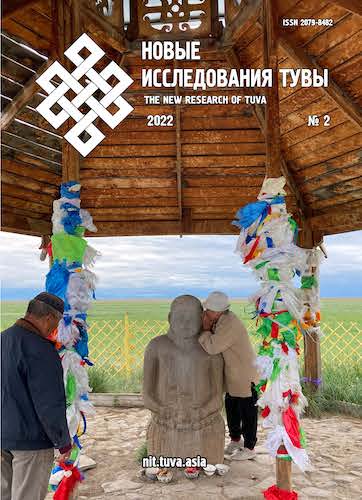Ethnic Resources of Tuva in National Policy Scenarios
DOI:
https://doi.org/10.25178/nit.2022.2.13Keywords:
transborder areas; ethnic facrtor; national policy; Tuva; MongoliaAbstract
The borderlands often make up a new transborder entity featuring unique social, cultural and political resources that may be ethnically tinged when those areas are inhabited by transborder or culturally similar ethnic minorities. Although researchers have long been interested in borderlands, the role of the ethnic factor in their rise and life has so far rarely been a subject of systematic research. This article focuses on the ethnic potential of Russian Federation’s Republic of Tuva that borders Mongolia and has close historical connections with China.
Elaborating on the current practices of its leverage, the author arrives at a paradox: despite having a significant ethnic capability of Tuva under its control, the state currently makes very little use of it. The article argues that the real reason behind this paradox is the reluctance to accept the otherness of the border area population. This otherness is often seen as a threat instead of embracing it with all the cultural difference it entails.
The article proposes a shift in borderlands policy and suggests a set of measures for incorporating the ethnic capability of the Tuvan borderlands into the single cultural, economic and political space of the country.
References
Bakaeva, E. P. (1994) Buddizm v Kalmykii. Istoriko-etnograficheskie ocherki [Buddhism in Kalmykia: Historical and ethnographic essays]. Elista, Kalmyk Publishing House. 128 p. (In Russ.).
Baldano, M. N. (2015) Protsess natsional'nogo stroitel'stva v sovremennoi Buriatii: transgranichnye vyzovy — riski i vozmozhnosti [The process of nation building in contemporary Buryatia: cross-border challenges — risks and opportunities]. In: Transgranichnye vyzovy natsional'nomu gosudarstvu [Cross-border challenges to the nation state] / ed. by S. Panarin. St. Petersburg, Inter-sotsis. 389 p. Pp. 282–304. (In Russ.).
Bicheldei, K. A. (2014) Osobennosti istoricheskogo momenta v Uriankhaiskom krae mezhdu nachertaniiami Nikolaia II «Soglasen» i «Uspeshno» v 1914 godu [Historical momentum in Uryakhai krai between two 1914 resolutions by Russian emperor Nicholas II: “I concur” and “Successful”]. New Research of Tuva, no. 3, pp. 14–33. (In Russ.).
Vvedenie v issledovaniia granits [Introduction to borderlands research] (2016) / ed. by S. V. Sevast'ianov, Yu. Laine and A. A. Kireev. Vladivostok, Dal'nauka. 426 p. (In Russ.).
Voronchenko, T. V. and Sokol'skikh, N. N. (2012) Transformatsiia kul'tury pogranich'ia v usloviiakh globalizatsii [Transformation of borderland culture in the context of globalization]. Gumanitarnyi vector, no. 3(31), pp. 187–192. (In Russ.).
Zhukovskaia, N. L. (2008) Buddizm i shamanizm kak faktory formirovaniia buriatskogo mentaliteta [Buddhism and Shamanism as factors in the formation of the Buryat mentality]. In: Religiia v istorii i kul'ture mongoloiazychnykh narodov Rossii [Religion in the History and culture of the Mongolian-speaking peoples of Russia] / ed. by N. L. Zhukovskaia. Moscow, Vostochnaia literatura. 319 p. Pp. 9–36. (In Russ.).
Lamazhaa, Ch. K. (2021) Tuva kak limitrofnaia zona: iazyk, religiia i identifikatsiia naseleniia [Tuva as a limitrophe zone: language, religion and people’s identity]. New Research of Tuva, no. 3, pp. 178–194 (In Russ.). DOI: https://www.doi.org/10.25178/nit.2021.3.14
Lamazhaa, Ch. K. and Suzukei, V. Yu. (2019) Tuvinskoe gorlovoe penie kak nematerial'noe kul'turnoe nasledie i kak kul'turnyi brend Tuvy [Tuvan throat singing as intangible cultural heritage and as Tuva’s cultural brand]. New Research of Tuva, no. 2, pp. 72–83. (In Russ.). DOI: https://doi.org/10.25178/nit.2019.2.6
Likhachev, D. S. (1996) Ocherki po filosofii khudozhestvennogo tvorchestva [Essays on the philosophy of artistic creativity]. St. Petersburg, Rus.-balt. inform. tsentr «Blits». 158 p. (In Russ.).
Machiavelli, N. (2018) Gosudar' [The Prince]. St. Petersburg, Azbuka. 512 p. (In Russ.).
Mikhalev, M. S. (2018a) Malye narody v kontekste prirodookhrannoi deiatel'nosti: zashchishchaiushchie ili zashchishchaiushchiesia? [Indigenous nations in the context of environmental protection: protecting something or defending from something?]. Gumanitarnye issledovaniia v Vostochnoi Sibiri i na Dal'nem Vostoke, no. 3(45), pp. 94–102. (In Russ.).
Mikhalev, M. S. (2018b) Prazdnovanie sagaalgana u buriat Rossii i Kitaia: Sotsial'no-politicheskoe izmerenie narodnogo prazdnika [The celebration of sagaalgan by the Buryats of Russia and China: A socio-political dimension of the national holiday]. Traditsionnaia kul'tura, no. 1(69), pp. 40–51. (In Russ.).
Mikhalev, M. S. (2019a) Prigranich'e — territoriia skrytykh vozmozhnostei. K voprosu o korrektirovke issledovatel'skoi paradigmy [Borderlands as the territory of hidden opportunities: towards a change in the research paradigm]. Tsentr i periferiia, no. 1, pp. 4–10. (In Russ.).
Mikhalev, M. S. (2019b) O vliianii massovogo turizma na kul'turu, obraz zhizni i identichnost' tuvintsev Sin'tsziana [On the impact of mass tourism on the culture, lifestyle and identity of Tuvans in Xinjiang]. Traditsionnaia kul'tura, no. 2, pp. 23–35. (In Russ.).
Mollerov, N. M. (2014) Protektorat Rossii nad Tuvoi v 1914–1924 gg. (istoriko-pravovoi aspekt) [The protectorate of Russia over Tuva in 1914–1925 (an historic and legal aspect)]. New Research of Tuva, no. 3, pp. 47–57. (In Russ.).
Mongush, M. V. (2001) Istoriya buddizma v Tuve (vtoraya polovina VI — konets XX v.) [The History of Buddhism in Tuva (latter half of the 6th — late 20th cc.)]. Novosibirsk, Nauka. 200 p. (In Russ.).
Mongush, M. V. (2010) Odin narod: tri sud'by. Tuvintsy Rossii, Mongolii i Kitaia v sravnitel'nom kontekste [One people, three destinies. Tuvans of Russia, Mongolia and China in a comparative context]. Osaka, Natsional'nyi muzei etnologii. 358 p. (In Russ.).
Morokhoeva, Z. (2012) Vstupitel'noe slovo [Opening remarks]. In: Pogranich'e kul'tur — kul'tury pogranich'ia [Borderlands of cultures — cultures of the borderlands] / ed. by Z. Morokhoeva / DEBATY ARTES LIBERALES. T. VI. Warszawa, Instytut Badań Interdyscyplinarnych «Artes Liberales», Uniwersytet Warszawski. 312 p. P. 5–9. (In Russ.).
Khabudaeva, V. A. (2014) Natsional'nye prazdniki v sisteme traditsionnykh sotsiokul'turnykh tsennostei buriatskoi molodezhi [National holidays in the system of traditional socio-cultural values of Buryat youth]. Vestnik Buriatskogo gosudarstvennogo universiteta, no. 14(2), pp. 43–46. (In Russ.).
Tsymburskii, V. L. (2000) Rossiia — Zemlia za Velikim Limitrofom : tsivilizatsiia i ee geopolitika [Russia — The Land beyond the Great Limitrophe: Civilization and its Geopolitics]. Moscow, Editorial URSS. 144 p. (In Russ.).
Chzhao Nan' (2013) 赵楠. 别样的童年——民族旅游背景下的儿童成长启示 [Different childhood: lessons of growing up against the background of ethnic tourism]. Pekin, Universitet natsional'nostei. 91 p. (In Chinese)
Yusha, Zh. M. (2017) Tuvintsy Kitaia v XXI veke: vekhi istorii i sovremennoe sostoianie [Tuvans in 21st century China: history and contemporary situation]. New Research of Tuva, no. 1, pp. 101–117. (In Russ.).
Barth, F. (1969) Ethnic groups and boundaries the social organization of culture difference. Boston, Little Brown. 153 p.
Hou Yuxin (2014) The Analysis of Current Situation of Tuva people in China. New Research of Tuva, no. 1, pp. 96–103.
Steinberg, J. (2011) Ismaili Modern: Globalization and Identity in a Muslim Community. Chapel Hill, The University of North Carolina Press. 234 p.
Wilson, T. M. and Donnan, H. (1998) Border Identities. Nation and State at International Frontiers. Cambridge, Cambridge University Press. 301 p.
Published
How to Cite
For citation:
Mikhalev M. S. Etnicheskii potentsial Respubliki Tuva v stsenariiakh gosudarstvennoi politiki [Ethnic Resources of Tuva in National Policy Scenarios]. New Research of Tuva, 2022, no. 2, pp. 188-197. (In Russ.). DOI: https://www.doi.org/10.25178/nit.2022.2.13
Issue
Section

This work is licensed under a Creative Commons Attribution-NonCommercial 4.0 International License.

Author(s) license holder(s) grant rights for their work to the journal (grantee of a license) under the simple non-exclusive open license in accordance with Art. 1286.1 «Open license for a research work, work of literature or fine arts», Civil Code of the Russian Federation.
New Research of Tuva publishes articles under the Creative Commons Attribution-NonCommercial license (CC BY-NC).
Since it is an open license, author(s) reserve the right to upload the article to their institutional repository, submit it to another journal (if it allows republications), or republish it on their own website (in full, or in part).
However, several conditions apply here:
a) The republished version must always contain the name(s) and affiliation(s) of the author(s), the original title and the hyperlink to the original version on the New Research of Tuva website;
b) It must be in open access, free of charge, and no category of readers must be in any way whatsoever advantaged over general readership.
c) should the contribution be submitted elsewhere by its author(s) without substantial modification (30% or more of original text unchanged), the body of the article should contain a disclaimer that the original version was published in New Research of Tuva (with a link to the respective page)
The CC-BY-NC is a non-revocable license which applies worldwide and lasts for the duration of the work’s copyright.









